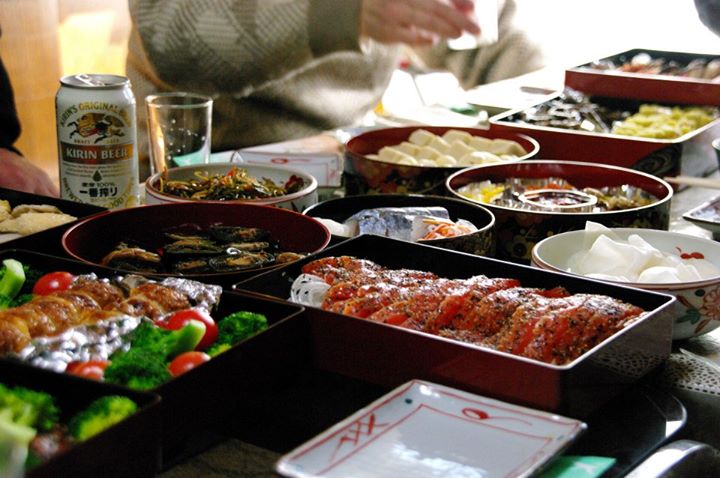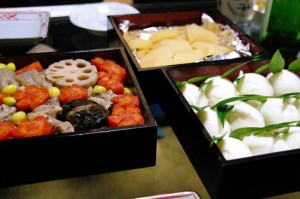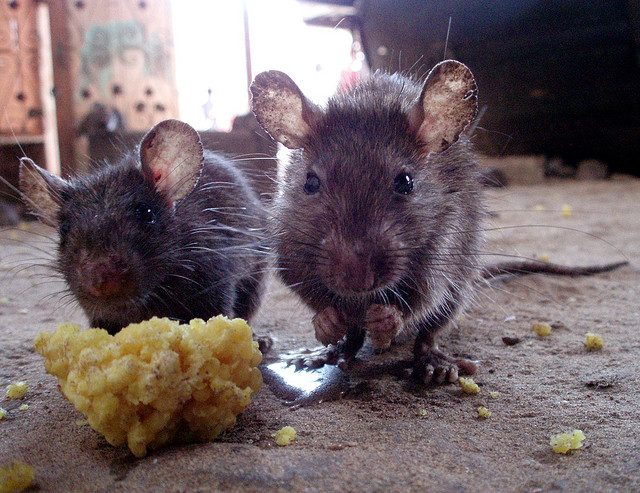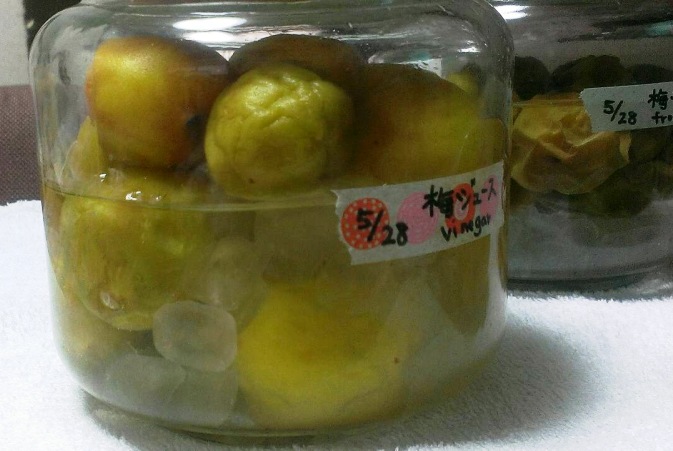Special Feature: A Beginner’s Guide to Osechi Ryori
In amongst the faux snow and strains of, “I’mmmmmm dreammingggg of a whiteeeeee Christmassssss”, you may have also seen in your department stores and supermarkets ornate square boxes filled with products in every colour, begging to be bought at obscene prices. A far cry from roast turkey (northern hemisphere) or seafood (southern), this is osechi ryori, the Japanese “Christmas Lunchâ€, eaten with family on 1 January. Characterised by its colourful layers, morsels are packed into special jubako boxes, particular care being taken with the arrangement and colours. While all edible, most food is more symbolic than delicious, directed towards ensuring prosperity, good fortune, and health in the New Year.
Traditionally, in the first three days of the New Year it was not permissible to use a hearth or cook meals. To survive, families spent the last days of December cooking masses of food containing ample amounts of sugar and vinegar, that would keep, unrefrigerated, for several days without spoiling. Now, similar to Christmas in the West, osechi ryori allows families to eat at home in the first days of the New Year when most stores are closed. The masses of food prepared also means that, for these days, tired housewives may have a break from their regular cooking duties.
If you are lucky enough to be spending Oshogatsu with a Japanese family this winter, here is a guide to what you may be eating.
Kazunoko. Tiny yellow herring roe, usually marinated in dashi, soy, and sake. When eaten, the roe has a bit of a crunch and is decidedly not delicious. The eggs are consumed as a wish for an abundant harvest and fertility.
Kuromame. Black soy beans, seasoned with sugar and soy for a soft and sweet taste. The word for bean, “mameâ€, is similar to the word for “hard work and good health.†Accordingly, eating kuromame is a foolproof, completely legitimate, and delicious way to ensure good health in 2014.
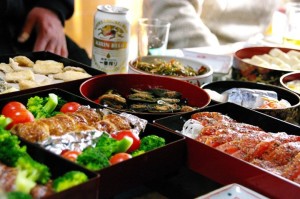 Gomame or tazukuri. Small dried sardines, finished in a sauce of sugar, mirin, soy and sake. As the original use of these fish was as fertiliser for rice, the literal meaning of “tazukuri†is “rice paddy maker.†The fish are symbolic of a rich harvest.
Gomame or tazukuri. Small dried sardines, finished in a sauce of sugar, mirin, soy and sake. As the original use of these fish was as fertiliser for rice, the literal meaning of “tazukuri†is “rice paddy maker.†The fish are symbolic of a rich harvest.
Datemaki. Looking a little like a castella sponge, this treat is similar to the ubiquitous tamago roll but made with fish or shrimp paste. Because of its resemblance to a scroll, eating datemaki expresses a wish for scholarship. Anyone studying for the Japanese proficiency test this year could do worse than try a few for luck.
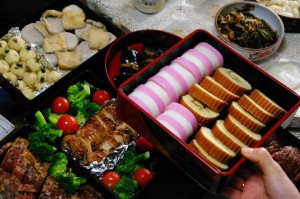 Kurikinton. A saccharine mash up of sweet potatoes and chesnuts. “Kinton†means golden dumpling, and is symbolic of gold and silver treasures. This is the dish to eat if you want your finances to look better in 2014.
Kurikinton. A saccharine mash up of sweet potatoes and chesnuts. “Kinton†means golden dumpling, and is symbolic of gold and silver treasures. This is the dish to eat if you want your finances to look better in 2014.
Kamaboko. Red (pink) and white fish cakes. The shape is said to represent the first sunrise of the year, and the colours are considered highly auspicious in Japanese culture.
Kohakunamasu. Red and white vinegar daikon and carrots. The colours represent mizuhiki, a twisted rice paper decorative cord that is used for special occasions.
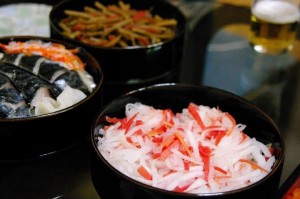 Gobo. Burdock root seasoned with sesame. The roots of the vegetable grow deep into the ground resembling a crane, a symbol of a fruitful year. Gobo is eaten to wish for good health and an abundant harvest.
Gobo. Burdock root seasoned with sesame. The roots of the vegetable grow deep into the ground resembling a crane, a symbol of a fruitful year. Gobo is eaten to wish for good health and an abundant harvest.
Prawn. With their long antennae and curved body, the prawns represent long life.
Sea bream. The fish is a symbol of auspicious fortune, and is eaten as a wish for many auspicious days.
Lastly, don’t forget Otoso, spiced sake, drunk to defeat the evil spirits of the previous year. If you want to prevent illness in 2014, it is recommended you have a lot of this.
If you haven’t yet latched onto a celebration, don’t worry. These foods can be bought at supermarkets all across Japan, and it is easy to find something suitable for your appetite and budget. You can also try your hand at being a Japanese homemaker, with most (most!) osechi recipes fairly easy to recreate.  More than anything, don’t miss the chance to ensure your good fortune for the New Year and enjoy a unique aspect of Japanese culture at the same time.
Kylie Pinder
With thanks to Kawasaki Sensei for confirming the veracity of the information supplied.
